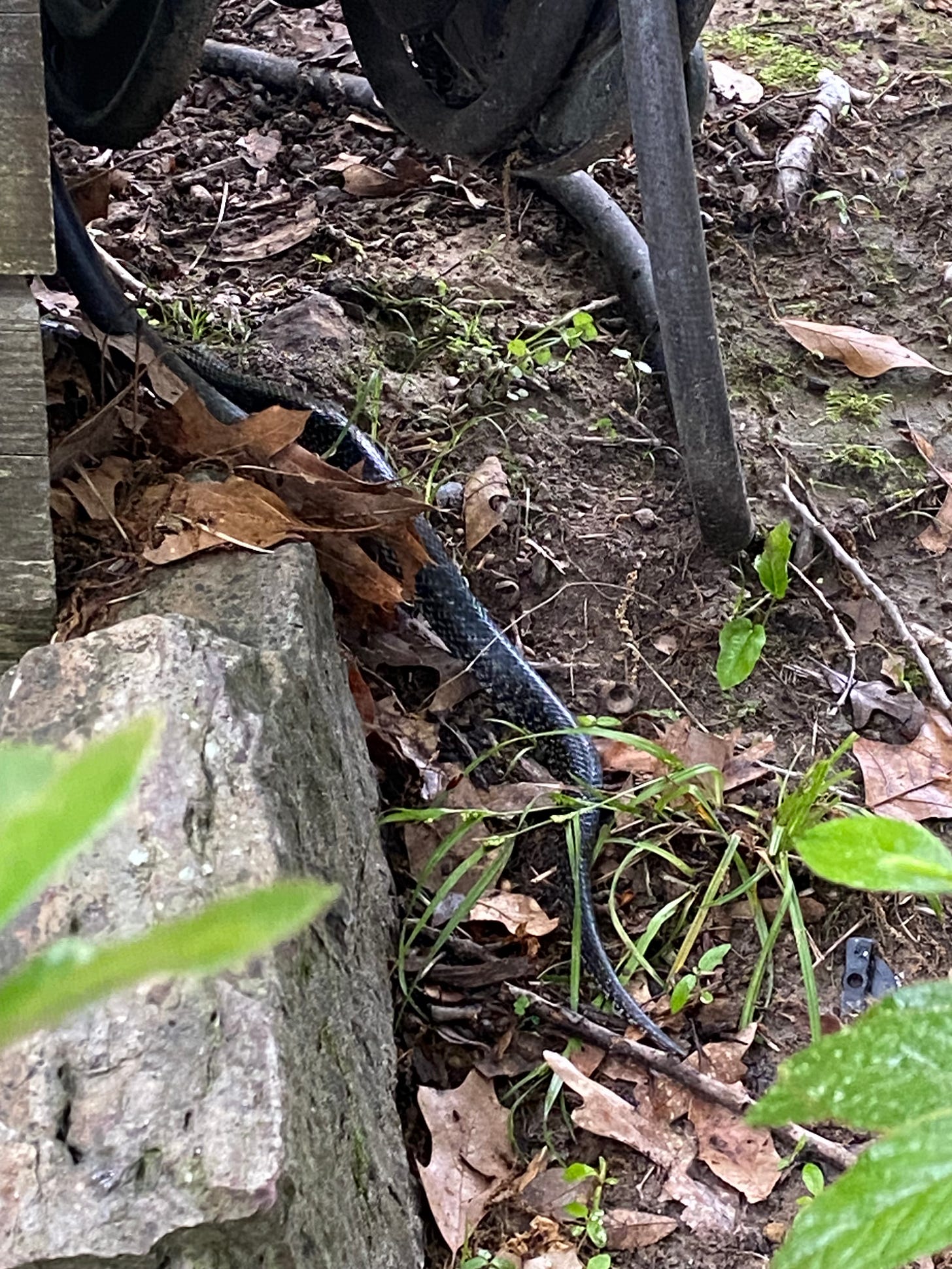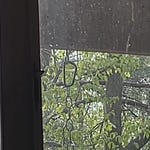After the owls left the hollow for the woods behind my yard, the parade of smaller wildlife began.
First, a former pet returned and greeted me at the front of my breezeway as I came down the steps. It was the Box Turtle.
When my boys were young, they found two turtles (aka terrapins) and we adopted them as pets. One was rounder and the other was longer and flatter, but we never tried to classify them. We put them in a large cardboard box with dirt, a bowl of water, and other familiar surroundings and fed them the correct food for their species. Sometimes we would put the box out on our deck to give them fresh air and sunshine. Alas, one day while I wasn’t watching, the round one managed to climb out of the tall box and fell off the deck, a 14-foot drop.
When I checked on the turtles that day and saw that one was missing, I ran downstairs and found him in the gravel and river rocks just next to the breezeway, upside down. I turned him over, and he appeared to be fine, his tough shell intact, and his spirit unbroken. I moved their box inside, but not long after that, the boys and I decided they might be happier and better off if we let them go.
Since then, every year or two we see one or the other in our yard. We’ve also had a variety of other turtles that don’t look quite the same; I saw two mating behind my fence and later found a tiny dead baby turtle in the grass a few years ago. I hope its siblings survived, wherever they were.
I have no way to prove that this is the same box turtle who’s been around for twenty years or more, but it looks just like the rounder, shorter one, and they can live that long. My brother-in-law says that most turtles never travel more than a few hundred feet their entire lives, so it’s plausible.
A day or so after I put him in the front yard, I saw my Australian Cattle Dog “Blue Heeler” puppy, Charlie, jump back from my old bin of lawn furniture cushions and bark, several times. My first thought was that he’d found a snake between the bin and the climbing hydrangea at the end of the breezeway, so I grabbed his collar and peered around to see what he was so excited about. It was Mr. Turtle again. My son came to visit me about that time and I asked him to put the turtle on the far side of the front yard so that Charlie wouldn’t see where it was.
Charlie, like my Blue Heeler Lucy before him, has a way of locating small creatures. He isn’t opposed to catching them if he’s in the mood, but he usually prefers to watch them—little frogs, a field mouse, a squirrel. He enjoys chasing birds, too. I had recently ordered him to drop a squiggly thing he’d caught in the dark by saying “Leave it!” and was amazed that he complied. Still, I was afraid he’d pick it up again so I put a big rock on top of it until I could come back and dispose of it. I thought it was a slug. When I came back sans Charlie, I found a four-inch lizard with part of its tail gone and part of its head squished. Another day, I found a tiny dead baby lizard, about an inch long, in the same area. Charlie was leaving it alone. At the age of nine months, he’ll eat almost anything, but he has his preferences and prefers dry linens and towels.
Lucy used to pick up turtles and toss them around the yard without hurting them until we rescued them, so I didn’t think Charlie would be a threat. The next day, insistent on hanging around, Mr. Turtle had come all the way around the front yard, slipped under the roses and the fence, and taken shelter under a small tree. Charlie found him, barked and howled, but didn’t attack. I petted him, told him the turtle was a friend, and led him away. From then on, the territorial turtle’s been here and there, happily foraging for whatever he wants to eat—bugs, worms, greens. Another day Charlie found him out in the breezeway, stood quietly, and leaned forward. He seems to have accepted that this turtle friend is harmless, but he still barks at it sometimes.
Three days ago, however, Charlie was barking a different kind of bark, crouching and staring at something under a bed of azaleas. I investigated. A black snake was sliding along peacefully, maybe a half inch in diameter. It didn’t look like a venomous snake, so I leaned closer, told Charlie, “Leave it!” and grabbed his collar. I watched as it headed toward the deck, our miniature covered wildlife refuge, and took a photo. It was much longer than I’d first thought. It had speckles all over, not yellow, like another king snake I’d seen in my yard years ago, but silvery. I’ll post someday about all the snakes, but for now, I looked up ‘king snakes.” There’s an amazing number of patterns and colors online, but this one appeared to be match the image of the “Black Speckled Kingsnake.” All king snakes are beneficial because they eat venomous snakes and other undesirable pests like mice and rats. They’re like little boa constrictors.
I was desensitized to snakes as a child by the boy next door, who kept them as pets, and I’ve never forgotten the book I read as a child about a beautiful snake named Maribelle that lived on a farm and got along with everyone. As a librarian with search expertise, I tried to find that book for years, with no success, until I posted this article on Substack and my friend Leah sent me a picture of her very own copy! What I remember most about the book is how sad I was when the story ended abruptly with the illustrated account of a hawk that picked Maribelle up and flew off with her. Just another children’s book where the animal protagonist dies brutally, with no compunctions on the part of the author, but I’ve ordered the copy I found on eBay nevertheless. I wish everyone would read No More Dead Dogs by Gordon Korman.
I don’t trust that single king snake to take care of every possible copperhead that might happen across my yard, so I called Critter Control to put out non-toxic snake deterrent. When the technician, Sean, arrived a couple of days ago to spray, we saw the turtle next to the old bin again. Charlie barked at Sean’s tank and spray wand until he put them down and was now barking at the turtle. Sean used to work in the herpetarium at the Memphis Zoo, and he carefully placed the turtle in a safe spot under the climbing hydrangea and sprayed all around my deck.
This morning, I was sitting in the Bird Room where I watch for my barred owls and happened to glance up at the hollow in my oak tree where they’ve nested so many times. I said to myself, “What! is that??” A curved blob was blending with the tree so well that I had to get the binoculars to see if it was a living creature or not. It was a raccoon, halfway in and halfway out of the hollow, clinging to it and pointing its little black mask and nose up, barely enough for me to identify it. I couldn’t tell what size or age it was, but I took a photo and three short videos before it went inside. My sister was visiting and took more photos later. I looked this afternoon and tonight, but I didn’t see anything in the hollow. This morning I caught it peeking out again. I can’t figure out if it’s a large baby or a small mama. I suspect it’s the mama, trying to figure out how to get her babies down from the twenty-foot height.
If you’ve read my previous posts, you’ll know about the raccoon that drove away the owls in 2022 and had her own babies in the hollow they had used for five years. If this one’s had babies in it this year, it explains what happened to the owls’ attempts at nesting. This raccoon looks young and doesn’t seem to know what to do. Time will tell. I’ll try to keep watch and let you know what happens next, in my backyard nature preserve.













Share this post